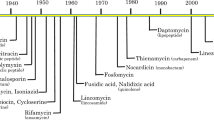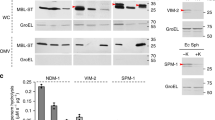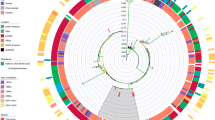Abstract
Discrepancies between resistance in vitro and therapeutic efficacy in vivo are generally attributed to failure of laboratory susceptibility tests to reflect an antibiotic's pharmacokinetic or pharmacodynamic properties. We show here that this phenomenon can result from differential in vitro–in vivo expression of bacterial determinants of antibiotic susceptibility. We found that an in vivo–induced virulence factor, Hpt, also mediates uptake of fosfomycin in Listeria monocytogenes. These bacteria therefore seem resistant to fosfomycin in vitro, although they are in fact susceptible to the antibiotic during infection.
This is a preview of subscription content, access via your institution
Access options
Subscribe to this journal
Receive 12 print issues and online access
$209.00 per year
only $17.42 per issue
Buy this article
- Purchase on Springer Link
- Instant access to full article PDF
Prices may be subject to local taxes which are calculated during checkout


Similar content being viewed by others
References
Bishai, W. J. Antimicrob. Chemother. 49, 433–436 (2002).
Varaldo, P.E. J. Antimicrob. Chemother. 50, 1–4 (2002).
Vázquez-Boland, J.A. et al. Clin. Microbiol. Rev. 14, 584–640 (2001).
Freitag, N.E. & Jacobs, K.E. Infect. Immun. 67, 1844–1852 (1999).
Vega, Y. et al. Mol. Microbiol. 52, 1553–1565 (2004).
Hof, H., Nichterlein, T. & Kretschmar, M. Clin. Microbiol. Rev. 10, 345–357 (1997).
Troxler, R., von Graevenitz, A., Funke, G., Wiedeman, B. & Stock, I. Clin. Microbiol. Infect. 6, 525–535 (2000).
Ermolaeva, S. et al. Mol. Microbiol. 52, 601–611 (2004).
Chico-Calero, I. et al. Proc. Natl. Acad. Sci. USA 99, 431–436 (2002).
Kadner, R.J. & Shattuck-Eidens, D.M. J. Bacteriol. 155, 1052–1061 (1983).
Ripio, M.T., Brehm, K., Lara, M., Suárez, M. & Vázquez-Boland, J.A. J. Bacteriol. 179, 7174–7180 (1997).
Michelet, C., Avril, J.L., Cartier, F. & Berche, P. Antimicrob. Agents Chemother. 38, 438–446 (1994).
Gobernado, M. Rev. Esp. Quimioter. 16, 15–40 (2003).
Joukhadar, C. et al. J. Antimicrob. Chemother. 51, 1247–1252 (2003).
Sauermann, R. et al. Antimicrob. Agents Chemother. 49, 4448–4454 (2005).
Acknowledgements
We thank B. González-Zorn for advice on mouse experiments, S. Novella for assistance with the isolate collection, the personnel of the animal facility of the Universidad Complutense of Madrid (UCM) for animal care, and D. Lewis and C. Helps for reading the manuscript. We also thank F. Baquero for discussions. Mouse tests were performed when the group was based at UCM according to current regulations on animal experimentation. This work was supported by the Spanish Ministry for Science and Technology (grant BMC2000-0553), the European Commission (contract QLG2-CT-1999-00932), and in the UK by the Wellcome Trust (program grant 074020). M.W. was supported by a Schrödinger visiting fellowship from the Austrian Research Fund (J-1694).
Author information
Authors and Affiliations
Corresponding author
Ethics declarations
Competing interests
The authors declare no competing financial interests.
Supplementary information
Rights and permissions
About this article
Cite this article
Scortti, M., Lacharme-Lora, L., Wagner, M. et al. Coexpression of virulence and fosfomycin susceptibility in Listeria: molecular basis of an antimicrobial in vitro–in vivo paradox. Nat Med 12, 515–517 (2006). https://doi.org/10.1038/nm1396
Received:
Accepted:
Published:
Issue Date:
DOI: https://doi.org/10.1038/nm1396
This article is cited by
-
Translating eco-evolutionary biology into therapy to tackle antibiotic resistance
Nature Reviews Microbiology (2023)
-
Fosfomycin and nitrofurantoin: classic antibiotics and perspectives
The Journal of Antibiotics (2021)
-
Potential Antibiotics for the Treatment of Neonatal Sepsis Caused by Multidrug-Resistant Bacteria
Pediatric Drugs (2021)
-
Inducible degradation of lncRNA Sros1 promotes IFN-γ-mediated activation of innate immune responses by stabilizing Stat1 mRNA
Nature Immunology (2019)
-
Molecular diversity and antimicrobial susceptibility of Listeria monocytogenes isolates from invasive infections in Poland (1997–2013)
Scientific Reports (2018)



